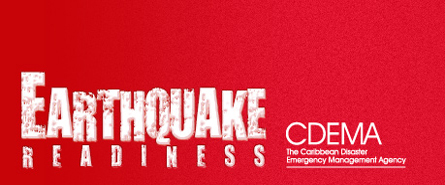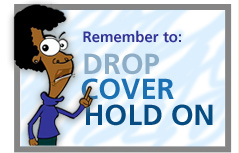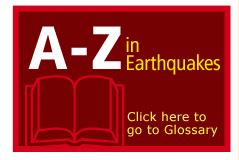|
Lesson Plan for Teachers
Thinking about earthquakes and what would be the most sensible thing to do if a serious earthquake were to happen, is important for all of your students. However, you need not carve special time out of your crowded syllabus in order to cover the information they need to know. You can use the material provided in this toolkit in a variety of ways that will satisfy syllabus requirements and still give your students information that may be life-saving.
Remember that we are now in the technological age. Thus it is useful to incorporate a multi-media component in your methods because today's student learns fastest with multi-media aids.
You will at least want to ensure that you discuss what you should do if an earthquake happens:
- What should you do while the earthquake is going on?
- What is the evacuation plan for your class after the earthquake?
Your level of preparation before you impart will determine how enriching the learning is for your students. Here are some tips to prepare:
Research songs, poetry and reports which you can use as icebreakers, attention getters and general learning materials. SEE SAMPLES
You might also want to try one or more of the following student activities at an appropriate time in your syllabus. See the following activities by subject below:
Art/Social Studies/History
Drama/Social Studies
Language Arts
See links below for some additional resources:
Lesson Plan for Art, Social Studies and History
- ART
- Have students try the following:
- Make a poster to show people your age what to do in an earthquake.
- In groups, or as a whole class, discuss with your class mates what you think should be in large print on the poster, and what (if anything) should be written smaller.
- Your poster should make it clear what are the most important things you think that people should know.
- SOCIAL STUDIES (GEOGRAPHY)
Discuss or write about the following:
- What makes earthquakes happen?
- Where are they most likely to happen?
- On the map of the world provided, colour in the areas where earthquakes are most likely to happen. SEE WORLD MAP
- Design an evacuation plan for your school. Draw a map showing where students should go, and how they should get there.
- Draw a plan for your home. In your plan, identify likely safe zones to be used during and after an earthquake and design evacuation routes.
- HISTORY
Homework /Research
- Find out about the most famous earthquakes in the world. Where and when did they happen? What sort of damage was caused? What lessons did we learn from them?
- Find out about Tsunamis which have occurred in the world. Where and when did they happen? What sort of damage was caused? What lessons did we learn from them?
back to top
Lesson Plan for Drama and Social Studies
In Class:
- DRAMA & SOCIAL STUDIES
- Have students make a plan of your school. Show the route that they would take to get out to the designated safe area after the earthquake.
- Have your class act out what they will do while the earthquake is going on. Make a noise by banging or shaking something for one full minute while they practice the "Drop, Cover, Hold" movements under their desks. Remind them that the USAID Handbook for Children tells them to be like a turtle - if your desk moves, move with it!
- After the "earthquake", have a practice evacuation.
When you return to your class, try the following activities:
- Discuss what features of the classroom might constitute a hazard in an earthquake.
- Suggest how these could be fixed or improved.
- Did your students encounter any difficulties with the evacuation?
- What were they, and how could they be resolved?
- If necessary, have the students amend their evacuation plan diagrams.
For homework:
Ask students to make an evacuation plan for their homes. They should draw the diagram/map showing the route family members should take.
Make a list of Do's and Don'ts
- Write a checklist of all the things you should do if an earthquake strikes your area.
- What should you definitely NOT do? Why?
Tip: Use Graphic Organizers when teaching things like Cause and Effect, and hand out Graphic Organizer templates for the Dos and Don'ts activity, so they can organize the information themselves. SEE TEMPLATES
Lesson Plan for Language Arts
Activities
Group and Individual Research:
Topics: What is an earthquake?
Earthquakes that have taken place anywhere in the world
Suggestions to students: Your research can have an electronic component. You may use newspaper clippings, article, pictures, sound clips, video clips in your report. Information can be compiled in a portfolio with a presentation to the class.
- Write out instructions for your classmates, explaining what they should do during and immediately after an earthquake, and why.
- Write a letter to a friend telling them about how things went during a recent earthquake.
- Write a story about a person who suffered because of an earthquake.
- A major earthquake has happened. Write a newspaper report about it.
- Develop an earthquake alphabet. In other words, find a word for as many of the letters of the Alphabet related to earthquake and earth science, using this template.
| A |
B |
C |
D |
E |
| F |
G |
H |
I |
J |
| K |
L |
M |
N |
O |
| P |
Q |
R |
S |
T |
| U |
V |
W |
X |
Y |
| Z |
|
|
|
|
Multimedia/Working Groups
Place students in groups and have each group develop one of the following multi-media tools on what to do during an earthquake:
- A Rap song
- A 60 second jingle
- A Calypso
- A Dance Hall song
- A Drop, Cover & Hold Dance routine
back to top
California Case Study
Case studies of severe earthquakes in industrialised countries have shown that death, injury and damage result primarily from unsecured non-structural elements.
The following is from a report on the non-structural damage that occurred to five schools shaken by an earthquake in California:
Windows - The 31 year-old junior high library had eight-by-ten foot double height glass windows on the north and south walls. All windows imploded and littered the room. There were dagger-shaped pieces everywhere. The floor tile and wooden furniture were gouged with flying glass. The school superintendent believes that, had school been in session, death and serious injury would have occurred in the library. The glass in the library windows was not tempered.
Lights - Approximately 1,000 fluorescent bulbs fell from their fixtures and broke. Many fixtures also came down. There were no safety chains on the fixtures. Although hanging fixtures suffered much more damage than recessed fixtures, glass in the older recessed fixtures was shaken out and broke. The elementary school library lost all its fixtures.
Chemicals - In the second-floor high school chemistry lab, sulphuric acid and other chemicals stored in glass containers in open cabinets overturned and broke. Acid burned through to the first floor. Cupboard doors sprang open and glass cabinet doors broke, allowing chemicals to fall. The lack of electric ventilation caused toxic fumes to permeate the building.
Equipment - File cabinets flew across the room; bookcases fell over; freestanding cupboards, cabinets and shelving fell. Machine shop lathes and presses fell over.
|













